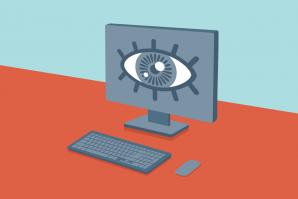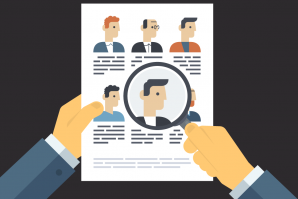Your boss tells you, “This change is for the best,” but as she speaks, you notice her stiffened posture and forced smile. Your co-worker says he’d be happy to help you with your project, but he seems to pause a long time before answering, and while talking, his eyes stay fixed on his computer monitor. Can you trust what they say?
Recognizing key signs of dishonesty and deception is a professional skill that can pay off in spades. For the vast majority of individuals, the act of lying triggers a heightened stress response. Blood pressure, heart rate and breathing rate all increase, and if you’re keen, you can see people’s body language change as they try to manage their anxiety. So unless you’re dealing with a sociopath or a superb actor, you can spot those who try to mislead you by monitoring their nonverbal signals. Here’s how:
Know your subject. Everyone reacts to stress in his or her own way. That’s why spotting deceitfulness begins with observing a person’s normal behavior under relaxed or generally stress-free conditions so you can detect meaningful deviations from that baseline.
To relieve stress, liars may use pacifying gestures, such as hand wringing or hair twirling. But our first biological response to stress is to freeze in place. If your typically animated colleague suddenly stops gesturing, has a forced or frozen smile, holds his breath or locks his ankles, you should pay attention. If you rarely see your subordinate rub her temples or legs and she begins to do so as you confront her, you might want to increase your awareness.
But what if you’re entering into a confrontation or negotiation with someone you don’t know well? Before the session begins, over coffee and small talk, ask a series of simple questions while observing how the person behaves when there is no reason to lie. Then, when the more difficult issues get addressed, stay alert for sudden changes in behavior that may indicate duplicity around key points.
Pay attention to the details.Stress affects the entire body. When lying, a person’s voice will rise to a higher pitch as tension constricts the throat muscles. Under stress, people may also experience an increased need to drink water and to lick or moisten their lips as the autonomic nervous system downloads a rush of adrenaline, causing a dry mouth. People will often display apprehension and anxiety through increased foot movements. Feet may fidget, shuffle and wind around each other or the furniture.
Stay alert for the Pinocchio effect. A person’s nose may not grow when she tells a lie, but when someone is about to bluff or make an outrageous statement, she’ll often unconsciously rub her nose. (This is most likely because an adrenaline rush opens the capillaries and makes the nose itch.) Mouth covering is another common gesture of people who are being untruthful, as is rubbing or even covering the eyes.
Eyes are the window to the soul. The biggest body language myth about liars is that they avoid eye contact. In fact, many liars, especially the most brazen, overcompensate (to prove that they are not lying) by making too much eye contact and holding it too long. Two eye signals, however, are more accurate signs of dishonesty. One signal that is almost impossible to fake is pupil dilation. The larger pupil size that most people experience when telling a lie can be attributed to an increased amount of tension and concentration. The other signal is a change in blink rate. Research shows that a person’s blink rate slows down as he decides to lie and stays low through the lie. Then it increases rapidly (sometimes up to eight times the normal rate) after the lie.
Can’t fake a smile. It’s difficult for liars to give a genuine smile while seeking to deceive. Real smiles crinkle the corners of the eyes and change the entire face; faked smiles involve the mouth only.
Watch for mixed messages. When a person believes what she is saying, her gestures and expressions are in alignment with her words. When gestures contradict words, such as a person frowning and staring at the ground while telling you she is happy, it’s a sign of deceit or at least an inner conflict between what that person is thinking and saying.
It’s about the whole package. My best advice for reading another person’s body language (for any reason), is not to rely on any one nonverbal signal to tell you the whole story. You’ll be more successful if you look for clusters of behaviors, three or four body language cues that reinforce one another. Research into deception by David DeSterno at Northeastern University points to one specific cluster of nonverbal signals that has been statistically proven to accompany dishonesty. These are: hand touching, face touching, crossed arms and leaning away.
According to this research, if you see these “telltale four” being displayed during a conversation, watch out. These signals are strong indicators of heightened anxiety, possible deception and subject areas you should investigate further. But if a person really believes the lie, there is no way that you (or a polygraph, for that matter) can use stress reactions to detect falsehood.
Don’t overthink it. Don’t let your enthusiasm for exposing a cheat cause you to lose faith in all of the talented, productive, honest people you work with. The workplace, like any other gathering, is a dynamic, interactive setting. And when you expect your colleagues to be truthful and trustworthy, they will almost always rise to meet your expectations.
Recommended For You

Catty Chatting
When you need to reprimand a digitally dubious employee
I manage a group of about 13 people, and we communicate via instant messages. I have one employee who persistently bad-mouthed me in online conversations. I confirmed that he was aware that I could see his messages, and I told him I saw messages that concerned me. Since then, he’s disengaged from his job and is only doing the bare minimum. I feel I should address this with him, but I’m unsure of how to do so.

To Share or Not To Share
Mind your own business when it comes to background checks
What items gathered during the recruitment process can I share with others? We require approval from several parties before making an employment offer, and I am concerned that we may be sharing confidential information when “check complete” should be enough.

Figure of Speech
How body language factors into the glass ceiling
He’s the boss, she’s bossy. He’s assertive, she’s domineering. He strategizes, she schemes. He’s powerful and likeable, she’s powerful or likeable.

Back Off!
Micromanaging is toxic — here are 3 tips to help you stop today
At my first full-time job after college, the office manager routinely sorted through the recycling box to ensure that tossed junk mail had been cancelled with the sender. If someone from my department did not write the cancellation clearly enough, there was a lecture. This culminated in a 20-minute rant and the ultimate request to track all incoming junk mail, date of cancellation and subsequent mail on a spreadsheet for review. I refused. And then I quit.



